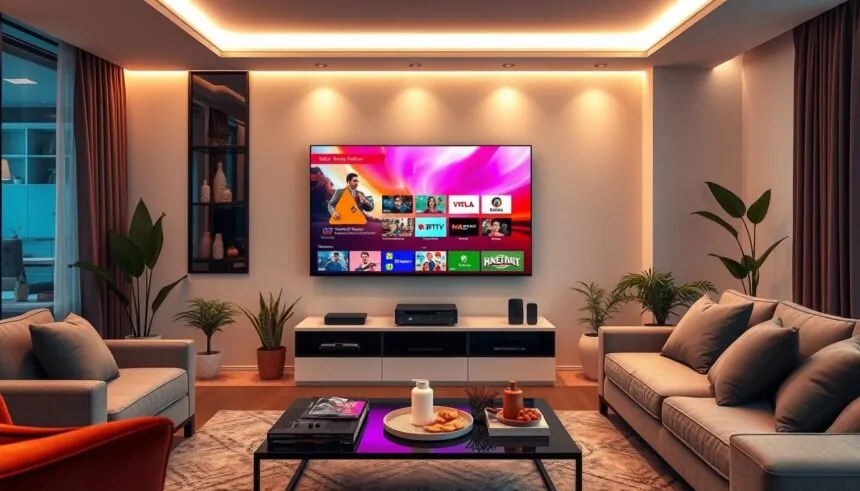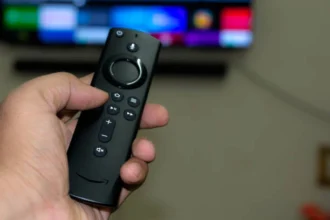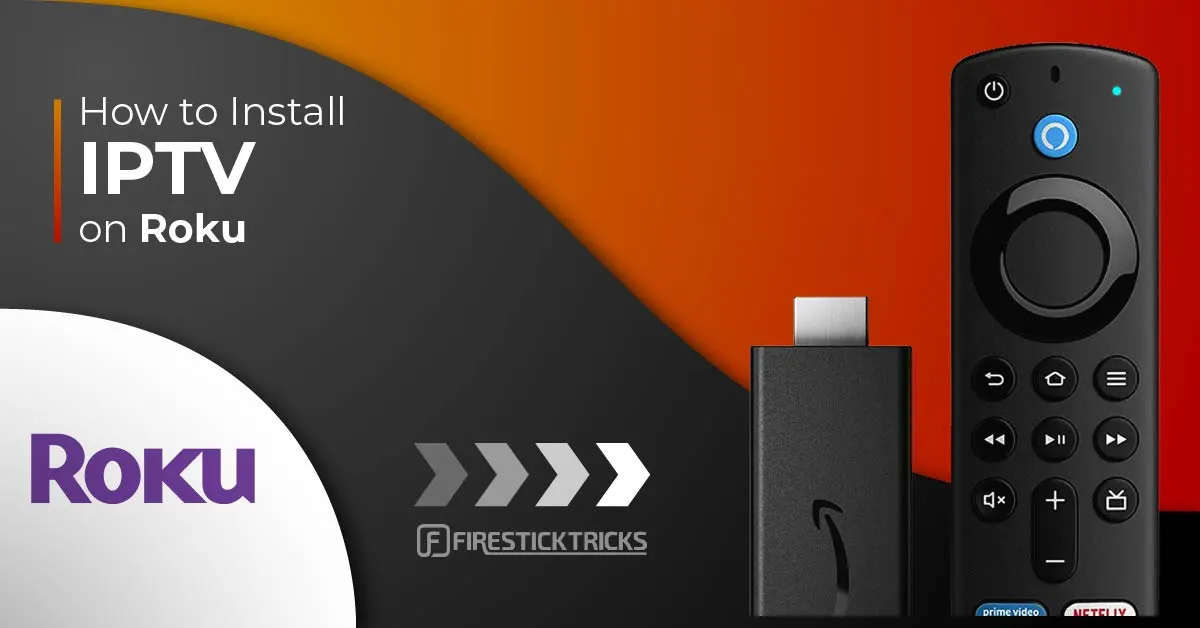In 2024, VLC Media Player is still a top choice for IPTV streaming. It has new features that make IPTV streaming better. This guide will show you how to get the most out of VLC Media Player 2024 for IPTV. You’ll learn how to make your IPTV streaming smooth and high-quality.
Key Takeaways
- VLC Media Player 2024 offers significantly improved IPTV streaming capabilities.
- New features and configurations designed specifically for Canadian IPTV solutions.
- Enhanced network streaming to optimize VLC viewing experience.
- Integration with tools like Wireshark, Tano, and XBMC for a comprehensive setup.
- Improved playback quality with adjustable buffer sizes and network settings.
Introduction to IPTV on VLC Media Player
The mix of Internet Protocol Television and VLC Media Player has changed how Canadians watch TV. IPTV lets users watch their favourite shows on many devices, like smartphones and smart TVs. It’s different from traditional cable because it doesn’t have hidden fees or long contracts.
With VLC benefits, watching TV becomes seamless and customizable. This makes the experience better for everyone.
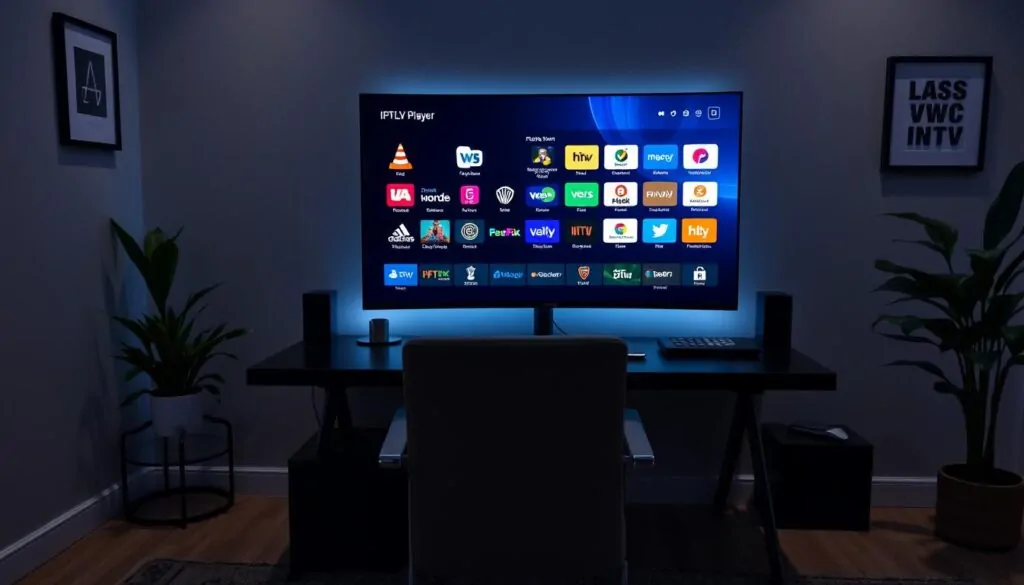
What is IPTV?
Internet Protocol Television (IPTV) delivers TV services over the internet, not through traditional means. It offers a wide range of channels, including Dutch and international ones. You can watch in HD and 4K, making TV more exciting.
Benefits of Using VLC for IPTV
VLC Media Player is a free, open-source player that works on many systems. It’s great for IPTV because of its benefits:
- Simple Setup for Streaming: It’s easy to start streaming IPTV channels with VLC.
- Customizable Settings: You can tweak video and audio settings for the best playback.
- Extensive Compatibility: VLC works with many streaming protocols, making it easy to manage IPTV channels.
- Recording and Plugins: You can record streams and use plugins like the Electronic Program Guide (EPG) to improve your experience.
VLC Media Player is a flexible way to enjoy IPTV. Learn more about setting it up and how freedom-stream.com can improve your TV watching.
Setting Up VLC Media Player for IPTV Streaming
Setting up VLC Media Player for IPTV streaming is easy. It works on many devices like Android, Windows, Mac, iOS, and Linux. This guide will help you set it up smoothly.
Downloading and Installing VLC
To start, you need to install VLC Media Player on your device. VLC works on many systems, including Android, iPhones, Windows PCs, MacBooks, Linux, and Amazon Firesticks. Here’s how to download and install VLC:
- Go to the VLC website and download the latest version for your system.
- Run the installer and follow the instructions to install it.
- After installing, open VLC Media Player to start the setup.
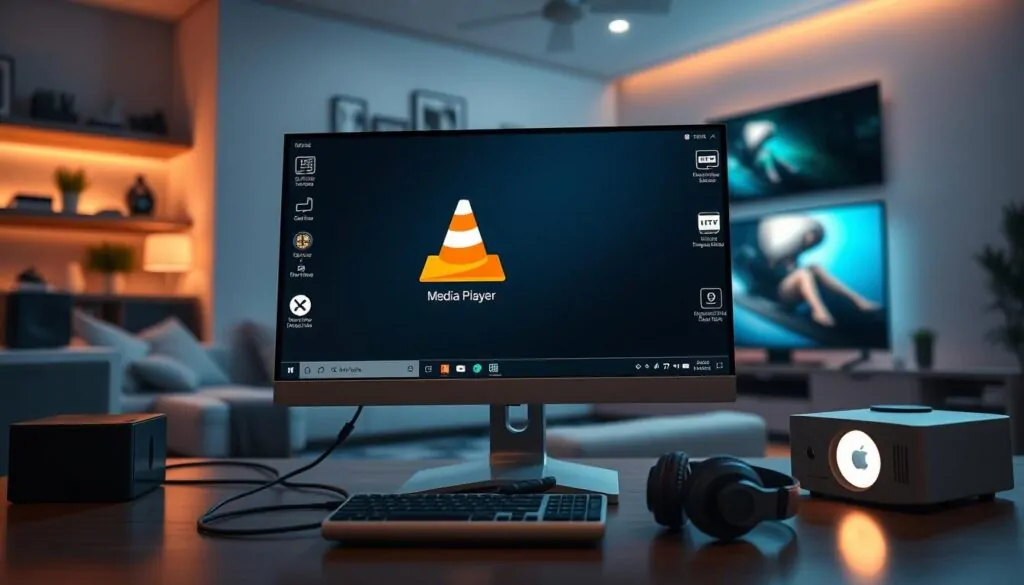
Configuring Basic Settings
After installing VLC, you need to configure VLC for IPTV for the best streaming. Here are the basic settings to adjust:
- Open VLC and go to the Preferences menu.
- In Preferences, choose the Input/Codecs tab.
- Change the Network Caching to 3000ms for better playback.
- Set your network MTU to 1500 for cable or 1498 for ADSL.
- Use the “FFmpeg” video codec for better video quality and compatibility.
These settings will help you stream IPTV smoothly and in high quality. For more details, see this guide on configuring VLC.
By following this VLC setup guide, you’ll enjoy better IPTV streaming. Remember, using a VPN like NordVPN can also protect your online activity while streaming.
Finding IPTV Streams Using Wireshark
Wireshark is a top network analysis tool. It makes it easy to catch IPTV streams. This guide will show you how to use Wireshark to analyze network data and grab IPTV streams.
What is Wireshark?
Wireshark is a leading open-source network analyzer. It lets users see and explore network traffic. With it, you can deeply analyze network data, find problems, and keep your network safe.
This tool has many features. They help with all kinds of network protocol analysis tasks.
Capturing IPTV Streams
To catch IPTV streams with Wireshark, follow these steps:
- Install Wireshark: Get and install Wireshark from its official site.
- Start Capturing: Open Wireshark and pick the network interface for your IPTV source.
- Apply Filters: Use filters to focus on IPTV protocols like UDP or HTTP. For example, udp.port==12000.
- Analyze Packets: After starting capture, look at the packets. Find specific multicast addresses and ports for IPTV streams.
- Identify Streams: Use the filter udp contains “payload” to find IPTV stream data.
By following these steps, you can easily catch your IPTV streams. Then, you can analyze them for things like playing them on VLC. This guide helps you use VLC and Wireshark together for better IPTV streaming.
Opening Network Streams in VLC
Opening a network stream in VLC Media Player is easy. It lets you watch a lot of IPTV content. Whether it’s live sports or TV shows, knowing how to open streams and fix problems makes watching better.
Steps to Open a Stream
Here’s how to open a network stream in VLC:
- Open VLC Media Player.
- Go to the “Media” menu and choose “Open Network Stream.”
- Type in the network URL (like http://192.168.1.2:8080).
- Click “Play” to start watching.
The default port for network streams is 8080. You can get the VLC Media Player app from the Google Play Store for Android TV or Roku.
Common Errors and Fixes
Users sometimes run into VLC network stream errors. Here are some common problems and how to fix them:
- Pre-buffering Issues: Make sure your internet is stable. Try reducing VLC’s buffer cache size in settings.
- Connectivity Issues: Check if your streaming device and source are on the same network.
- Codec Problems: Try different codec options, like H.264 + MP3 (TS) or MPEG4 1080p, to fix playback issues.
- Outdated Software: Always update VLC to the latest version for the best streaming.
“When streaming from VLC to Chromecast or Android TV, ensure both devices share the same network for seamless playback.”
Older VLC versions needed manual stream type selection and inputting port, address, or URL. Newer versions make it easier. Updating to the latest version can help fix VLC errors.
Creating and Managing Channel Lists with Tano
Using Tano for IPTV channel list management can really improve your TV watching. Tano works well with IPTV services to organize, scan, and save channels. It’s great for anyone who wants to make their VLC IPTV channels easier to use. Here’s how to set it up and use it to its fullest.
Setting Up Tano
Setting up Tano is easy. First, download it from the official website and follow the instructions. Tano has over 2,500 contributions, making it the biggest ever. It has 15 new integrations and updates to 13 others, making it easier to use.
It supports diagnostics in 61 integrations, like Z-Wave JS, Sonos, and Roku. This means Tano works well with your IPTV setup.
SurfIPTV is a good service to use with Tano. It offers lots of content and a reliable stream in Canada. After installing Tano, go to settings and enter your IPTV service details. This includes the server URL and your login info for easy connection.
Scanning and Saving Channels
After setting up Tano, scan for VLC IPTV channels. Go to the channel scan option in Tano and start the scan. Tano will find and list all channels, including sports, movies, and international shows. Its enhanced diagnostics feature supports many integrations for a full scan.
After scanning, save the channels to a list for easy access. This makes Tano great for managing channels. You can organize them how you like. Save the list and import it into VLC for a better viewing experience.
Using Tano for IPTV makes managing channels easy. It works well with VLC IPTV channels. With Tano and services like SurfIPTV, you get a top-notch streaming experience.
Improving Playback Quality on VLC
To get the best out of your IPTV on VLC Media Player, tweak some settings. Adjusting buffer sizes and network settings can make a big difference. A well-set VLC can greatly improve video quality, cutting down on lag and buffering.
Adjusting Buffer Sizes
Changing VLC buffer settings can really boost video quality. It lets VLC load video ahead of time, reducing stops. To tweak the buffer size:
- Open VLC Media Player and go to Preferences.
- Navigate to the Input/Codecs tab.
- Look for the File caching (ms) option and up its value. A higher value like 1000ms can cut down on playback problems. For network streams, adjust the Network caching (ms) the same way.
Optimizing Network Settings
Improving VLC performance also means tweaking network settings for IPTV. Adjusting these settings can make your connection more stable and streaming smoother. Here’s how to do it:
- Make sure your network drivers are current. Check the manufacturer’s site or use Windows Update for updates.
- Change the ‘Skip H.264 in-loop deblocking filter’ setting in VLC to ‘All’ for smoother video.
- If you have an NVIDIA graphics card, change the colour range to full dynamic range (0-255) instead of the limited range (16-235) in the NVIDIA Control Panel. Intel HD graphics card users should pick Full Range in Driver Settings.
Also, using DirectRaw as the video output setting in VLC and picking the right color conversion settings can really boost playback quality. Here’s how:
- Go to Preferences in VLC.
- Navigate to the Video tab.
- Change the Output to DirectRaw.
Lastly, applying filters under Essential and Video Effects in VLC can also improve video quality. Decoding more threads and adjusting file cache values can make 4K video playback smoother, ensuring a great IPTV experience.
Using XBMC for Enhanced IPTV Experience
Using XBMC with VLC can make your IPTV viewing better. XBMC, now known as Kodi, has features that make watching IPTV easy. This guide will show you how to set up XBMC and watch live TV on it.
How to Integrate XBMC with VLC
XBMC and VLC work together to improve your IPTV watching. Here’s how to start with XBMC integration:
- Install the latest XBMC (v11.0, Eden, is best for stable use).
- Get and set up VLC Media Player if it’s not on your system.
- In XBMC, go to settings and pick “Add-Ons.”
- Find and install the “VLC launcher” add-on. It lets XBMC use VLC.
- Set up the add-on by telling it where VLC is on your system.
- Restart XBMC and play a video to check if it works well with VLC.
Setting Up Live TV on XBMC
Setting up live TV on XBMC is easy with the right steps. Here’s how to do it:
- Go to “System,” then “Settings” from the XBMC home screen.
- Choose “Live TV” and turn it on.
- Go to “Add-ons,” then “PVR Clients.”
- Install the “IPTVSimple PVR” add-on. It’s key for IPTV streams in XBMC.
- Enter your m3u8 playlist URL in the add-on settings. This URL should have live TV channels.
- Also, enter the EPG URL for a full viewing schedule.
- After setting it up, go back to the home screen. You’ll see a “Live TV” section with your channels.
Integrating XBMC with VLC and setting up live TV changes your IPTV watching. It adds flexibility and better content management. Try these features and make your IPTV setup even better!
Updates and New Features in VLC (2024)
The year 2024 is a big year for VLC with lots of updates. These updates aim to make the user experience better. They include new features and enhancements designed for today’s users. Let’s explore the key updates and improvements of 2024.
VLC 3.0.21 was released on June 10, 2024. It’s the 22nd update to the 3.0 branch. This version has many improvements, such as:
- Updated codecs for better playability
- Super Resolution for sharper visuals
- VQ Enhancement filtering for AMD GPUs
- NVIDIA TrueHDR generating HDR from SDR sources
- Improved subtitle rendering for Asian languages, particularly on macOS
On February 16, 2024, VLC for iOS, iPadOS, and Apple TV got a big update to version 3.5.0. This update brought exciting new features, including:
- Playback history to keep track of watched content
- A to B playback for repeat watching
- Siri integration for hands-free operation
- Support for external subtitles and audio tracks
- Ability to favourite folders on local network servers
- Enhanced CarPlay integration
VLC 3.0.20 was released on November 2, 2023. It was a medium update with codec updates and fixes for playback issues. It notably:
- Resolved FLAC quality issues
- Enhanced playback support for multiple formats
- Fixed frame-by-frame action freezes
- Addressed audio layout issues on macOS
- Updated user interface translations
Throughout 2023, VLC also had several smaller updates. These updates improved VLC’s reliability and performance. Each update shows VideoLAN’s dedication to a top media player experience.
Tips for Seamless IPTV Streaming
Getting seamless IPTV streaming on VLC Media Player can make your viewing better. Here are some expert tips and IPTV best practices to help you avoid common problems. They will keep your stream quality high.
Common Issues and How to Solve Them
To get seamless IPTV streaming, knowing and fixing common issues is key. Here are fixes for some usual problems users face:
- Buffering Issues: Make sure your internet speed is at least 10 Mbps for standard definition. For high definition, it should be 25 Mbps. Using a wired connection can also help with stability.
- Connection Drops: Check and set up your router right, including NAT, firewall, and QoS. This will improve your streaming.
- Playback Quality: Changing buffer sizes and network settings in VLC can stop interruptions. It will make your viewing better.
Device Performance: Make sure your device can handle seamless IPTV streaming. It should have the right processor speed, RAM, and operating system. Setting up a special network for streaming can also help use bandwidth better.
Geo-Restrictions: A good VPN service can get past geo-restrictions. This lets you watch more IPTV content. It’s a key IPTV best practice for a stable and wide range of viewing.
By following these tips and fixing problems fast, you can have a smooth IPTV experience on VLC Media Player. For ongoing issues, check VLC troubleshooting guides. Also, keep your software up to date for more fixes and improvements.
Comparing VLC to Other IPTV Streaming Software
VLC is a top choice for IPTV software because it works with many formats. But, it’s good to see how it stacks up against other options like Tano. This comparison will help you find the best IPTV streaming software for you.
VLC vs. Tano
VLC and Tano are different in key ways. VLC is great for playing all sorts of media files. Tano, on the other hand, is made for IPTV streaming and makes it easy to manage channels.
Tano makes it simple to add and save channels. VLC needs more setup for IPTV but is still popular for its flexibility.
VLC vs. Other Media Players
VLC is known for being open-source and supporting many formats. But, other players like PowerDVD, KMPlayer, and PotPlayer have their own special features.
- PowerDVD: It’s rated 4.5/5 for compatibility and 5/5 for format support. It has cool features like TrueTheater™ Enhancements. It costs $4.58/month to subscribe.
- KMPlayer: It’s free and has a 4.4/5 rating. It supports YouTube and GIF Capture. It’s a great VLC alternative without the cost.
- PotPlayer: It’s rated 4.6/5 and supports subtitles and hardware acceleration. It’s also free, which is great for those watching their budget.
VLC is great for its flexibility and being free. But, if you want special features or a premium experience, you might choose PowerDVD.
Choosing the right IPTV software depends on what you need. Whether you want versatility, specialized IPTV features, or premium options, there’s something for everyone.
Customizing VLC for a Custom IPTV Experience
Customizing VLC can make your IPTV streaming better. By changing VLC skins and themes and using advanced VLC configurations, you can make VLC your own.
Skins and Themes
One way to make VLC your own is by trying out different skins and themes. Here’s how to install a new skin:
- Find a skin you like from places like VideoLAN or The Windows Club.
- Go to where VLC is installed on your computer.
- Find the ‘skins’ folder and put your .vlt file there.
- Open VLC and go to ‘Tools’ > ‘Preferences’.
- Go to interface settings and pick ‘Use custom skin’.
- Close VLC and open it again to see the new skin.
Some popular VLC skins are ‘Alienware Darkstar’, ‘MinimalX’, and ‘DarkLynx’. These not only look different but can also make using VLC easier and more fun.
Advanced VLC Settings
If you want to customize even more, there are lots of advanced VLC configurations. Here are some important changes:
- Buffer Size: Changing buffer sizes can make streaming smoother.
- Cache Values: Adjusting cache settings can stop playback from stopping.
- Video and Audio Effects: Tweaking contrast, brightness, or audio settings can improve your viewing and listening experience.
- Advanced Codec Settings: Setting up specific codecs can make certain streams work better.
By using these advanced settings, you can make VLC work just the way you want. This means you can enjoy your IPTV service without any hassle, making it a truly personalized experience.
Security Measures for IPTV Streaming
Keeping your IPTV streaming safe is key for a great experience. It’s important to protect your privacy and stop unauthorized access. By following safe streaming practices, you can keep your data safe while watching your favourite shows.
Safe Streaming Practices
Here are some tips for a secure IPTV streaming setup:
- Use trusted VPN services like PureVPN, ExpressVPN, CyberGhost VPN, or Private Internet Access (PIA) to hide your internet traffic and keep your privacy safe.
- Make sure your VPN has a no-log policy, fast servers, and supports 4K streaming. It should also prevent DNS and IPv6 leaks and stop bandwidth throttling.
- Always update your IPTV software and VPN apps to get the latest security updates.
- Stay away from free or unknown IPTV services, as they can risk your privacy.
Monitoring and Preventing Data Leaks
Stopping data leaks is crucial for IPTV security. Keep an eye on your streaming setup to spot and fix risks. Here are some important steps:
- Choose VPNs with strong leak protection, like PureVPN, ExpressVPN, and CyberGhost VPN. They hide your real IP address from threats.
- Use PIA’s MACE to block ads, trackers, and malware. This lowers the risk of running into bad stuff.
- Do regular security checks on your streaming devices to make sure they’re safe.
- Try different server locations with your VPN. This can help avoid being watched by your ISP.
By following IPTV security tips and watching out for data leaks, you can stream securely and protect your privacy.
Legal Considerations for IPTV Streaming in Canada
It’s key to know the IPTV legal guidelines for streaming in Canada. These rules help both providers and users follow Canadian streaming laws. They protect intellectual property rights and keep the industry standards high.
Geo-blocking is also important under Canadian streaming laws. It lets IPTV services follow local rules by blocking content in certain areas. So, while M3U IPTV offers lots of content, following local rules is crucial.
When picking an M3U subscription, think about the content, compatibility, and price. But most importantly, make sure it’s legal. Canadian users should choose IPTV services that follow the law for a smooth streaming experience.
Best IPTV Service Providers Compatible with VLC in Canada
To make your VLC Media Player better, we’ve found the best IPTV services in Canada. These services give you lots of live TV channels and VOD options. This means you get the best streaming experience.
Top Canadian IPTV Services
SurfIPTV is a top choice, with over 27,000 channels and 130,000 series and movies. They also have 24/7 customer support. IPTV Supra is another great option, with over 22,000 live channels and 130,000 VOD titles. They offer a 24-hour paid trial for $3.99 and support Canada and other countries.
IPTV Dream has over 20,000 live TV channels and 80,000 VOD titles. They also offer a 24-hour free trial. Their prices start at just $8 a month. CANADA IPTV has 18,000+ live channels and over 20 VOD packages. They also have a 7-day money-back guarantee. Loops IPTV has more than 25,500 channels and 100,000 series and movies.
How to Set Them Up on VLC
Setting up these IPTV services on VLC is easy. First, get an IPTV subscription from your chosen provider. Then, get your M3U playlist URL. Open VLC Media Player and go to ‘Media’ > ‘Open Network Stream’. Enter the M3U URL and click ‘Play’. Your channels will show up in VLC, letting you watch easily.
Make sure your internet is fast, at least 10 Mbps for standard definition. For high definition or 4K, you’ll need up to 25 Mbps. If problems arise, contact customer support or look for help online. With these top Canadian IPTV providers, VLC becomes a powerful streaming tool for a better viewing experience.
FAQ
What is IPTV?
IPTV stands for Internet Protocol Television. It lets you watch TV and on-demand content over the internet. This is different from traditional cable or satellite TV.
What are the benefits of using VLC for IPTV?
VLC Media Player is great for IPTV streaming. It supports many media formats and lets you customize settings. It also helps with buffering and network optimization.
How do I download and install VLC for IPTV streaming?
First, go to the VLC website. Choose your operating system and follow the installation steps. Then, adjust VLC settings for better IPTV streaming.
What is Wireshark and how does it help with IPTV streams?
Wireshark is a tool for analyzing network data, including IPTV streams. It helps you find and play back IPTV stream data in VLC.
How do I open network streams in VLC?
Open VLC’s “Media” menu and choose “Open Network Stream.” Enter the IPTV stream URL. If you face issues, check the troubleshooting tips.
How do I set up and use Tano for managing IPTV channel lists?
Install Tano and follow the setup guide. Use it to find and save IPTV channels. This makes managing your channels easier in VLC.
How can I improve playback quality on VLC for IPTV?
To better your VLC playback, tweak the buffer size and network settings. These changes can reduce lag and buffering during streams.
How do I integrate XBMC with VLC for an enhanced IPTV experience?
Install XBMC and set it to use VLC as the player. This combines XBMC’s features with VLC’s for a better IPTV experience.
What new features were introduced in VLC Media Player in 2024?
VLC’s 2024 update brought better IPTV support, advanced buffering controls, and network optimization. It also has new interface customization options.
What are some common issues with IPTV streaming on VLC, and how can I solve them?
Issues like pre-buffering and connectivity problems can occur. Check your network settings, adjust buffer sizes, and update VLC. Also, make sure your IPTV stream URLs are correct.
How does VLC compare to other IPTV streaming software like Tano?
VLC supports many formats and offers customization. Tano focuses on IPTV channel management. Choose based on your needs and preferences.
Can I customize VLC for a personalized IPTV experience?
Yes, VLC lets you change skins and themes. You can also adjust settings for a tailored IPTV experience.
What security measures should I adopt while streaming IPTV?
Use VPNs, keep software updated, and monitor network activity with Wireshark. These steps help protect your online privacy.
Are there any legal considerations for IPTV streaming in Canada?
Yes, IPTV streaming in Canada must follow intellectual property laws. Make sure you’re using legal IPTV services to avoid legal trouble.

